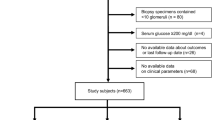Abstract
There is evidence pointing to a decrease of the glomerular filtration rate (GFR) in a subgroup of nephrotic children, likely secondary to hypovolemia. The aim of this study is to validate the use of urinary potassium to the sum of potassium plus sodium ratio (UK/UK+UNa) as an indicator of hypovolemia in nephrotic syndrome, enabling detection of those patients who will benefit from albumin infusion. We prospectively studied 44 nephrotic children and compared different parameters to a control group (36 children). Renal perfusion and glomerular permeability were assessed by measuring clearance of para-aminohippurate and inulin. Vaso-active hormones and urinary sodium and potassium were also measured. Subjects were grouped into low, normal, and high GFR groups. In the low GFR group, significantly lower renal plasma flow (p = 0.01), filtration fraction (p = 0.01), and higher UK/UK+UNa (p = 0.03) ratio were noted. In addition, non-significant higher plasma renin activity (p = 0.11) and aldosteron (p = 0.09) were also seen in the low GFR group.
Conclusion: A subgroup of patients in nephrotic syndrome has a decrease in glomerular filtration, apparently related to hypovolemia which likely can be detected by a urinary potassium to potassium plus sodium ratio > 0.5–0.6 suggesting benefit of albumin infusion in this subgroup.
What is Known: • Volume status can be difficult to assess based on clinical parameters in nephrotic syndrome, and albumin infusion can be associated with development of pulmonary edema and fluid overload in these patients. |
What is New: • Urinary potassium to the sum of urinary potassium plus sodium ratio can accurately detect hypovolemia in nephrotic syndrome and thus identify those children who would probably respond to albumin infusion. |

Similar content being viewed by others
Abbreviations
- Cr:
-
Creatinine
- FE Na:
-
Fractional sodium excretion
- FF:
-
Filtration fraction
- GFR:
-
Glomerular filtration rate
- IARF:
-
Idiopathic renal failure
- NS:
-
Nephrotic syndrome
- PAH:
-
Para-aminohippurate
- PRA:
-
Plasma renin activity
- RPF:
-
Renal plasma flow
- UK:
-
Urinary potassium
- UNa:
-
Urinary sodium
- U pr/Cr ratio:
-
Urinary protein/creatinine ratio
References
Agarwal N, Phadke KD, Garg I, Alexander P (2003) Acute renal failure in children with idiopathic nephrotic syndrome. Pediatr Nephrol 18(12):1289–1292
Branten A, Gerald Vervoort G, Wetzels J (2005) Serum creatinine is a poor marker of GFR in nephrotic syndrome. Nephrol DialTransplant 20:707711
Cavagnaro F, Lagomarsino E (2000) Peritonitis as a risk factor of acute renal failure in nephrotic children. Pediatr Nephrol 15(3–4):248–251
Chamberlain MJ, Pringle A, Wrong OM (1966) Oliguric renal failure in the nephrotic syndrome. Q J Med 35:215–235
Chen T, Lv Y, Lin F, Zhu J (2011) Acute kidney injury in adult idiopathic nephrotic syndrome. Ren Fail 33:144–149
Donckerwolcke RA, France A, Raes A, Vande Walle J (2003) Distal nephron sodium-potassium exchange in children with nephrotic syndrome. Clin Nephrol 59:259–266
Duffy M, Jain S, Harrell N, Kothari N, Reddi AS (2015) Albumin and furosemide combination for management of edema in nephrotic syndrome: a review of clinical studies. Cell 4:622–630
Khanna H, Chhabra R, Sharma D (2014) Minimal change nephrotic syndrome presenting as acute renal failure: an unusual seen complication. Sch J Appl Med Sci 2:3219–3221
Koomans HA (2001) Pathophysiology of acute renal failure in idiopatic nephrotic syndrome. Nephrol Dial Transplant 16:221–224
Meltzer JI, Keim HJ, Laragh JH, Sealey JE, Jan KM, Chien S (1979) Nephrotic syndrome: vasoconstriction and hypervolemic types indicated by renin-sodium profiling. Ann Intern Med 91:688–696
Park SJ, Shin JI (2011) Complications of nephrotic syndrome. Korean J Pediatr 54:322–328
Robson AM, Giangiacomo J, Kienstra RA, Naqvi ST, Ingelfinger JR (1974) Normal glomerular permeability and its modification by minimal change nephrotic syndrmone. J Clin Invest 54:1190–1199
Samuel S, Morgan CJ, Bitzan M et al (2013) Substantial practice variation exists in the management of childhood nephrotic syndrome. Pediatr Nephrol 28(12):2289–2298
Teoh CW, Robinson LA, Noone D (2015) Perspectives on edema in childhood nephrotic syndrome. Am J Physiol Renal Physiol 309(7):F575–F582
Vande Walle JG, Donckerwolcke RA, van Isselt JW, Derkx FH, Joles JA, Koomans HA (1995) Volume regulation in children with early relapse of minimal-change nephrosis with or without hypovolaemic symptoms. Lancet 346(8968):148–152
Vande Walle J, Donckerwolcke RA, Koomans HA (1999) Pathophysiology of edema formation in children with nephrotic syndrome not due to minimal change disease. J Am Soc Nephrol 10:323–331
Vande Walle J, Mauel R, Raes A, Vandekerckhove K, Donckerwolcke R (2004) ARF in children with minimal change nephrotic syndrome may be related to functional changes of the glomerular basal membrane. Am J Kidney Dis 43:399–404
Yamauchi H, Hopper J Jr (1964) Hypovolemic shock and hypotension as a complication in the nephrotic syndrome. Report of ten cases. Ann Intern Med 60:242–254
Author information
Authors and Affiliations
Contributions
Werner Keenswijk and Mohamad Ikram Ilias wrote the initial draft of this manuscript. All authors contributed to drafting, revising, and finalizing the manuscript and agreed with submission to the European journal of pediatrics.
Corresponding author
Ethics declarations
The study was performed in accordance with the Declaration of Helsinki and ethical approval was obtained from the hospital ethical committee.
Conflict of interest
The authors declare that they have no conflict of interest.
Additional information
Communicated by Mario Bianchetti
Rights and permissions
About this article
Cite this article
Keenswijk, W., Ilias, M.I., Raes, A. et al. Urinary potassium to urinary potassium plus sodium ratio can accurately identify hypovolemia in nephrotic syndrome: a provisional study. Eur J Pediatr 177, 79–84 (2018). https://doi.org/10.1007/s00431-017-3029-2
Received:
Revised:
Accepted:
Published:
Issue Date:
DOI: https://doi.org/10.1007/s00431-017-3029-2




